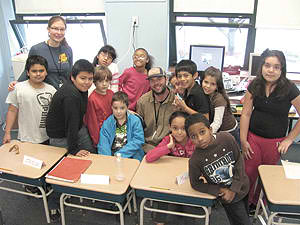
Athol farmer David Graham (center) and Tai Dinnan of Groundwork Somerville (upper left) talked to Mary McClellan's third grade class at East Somerville Community School as part of a Meet The Farmer program. – Photo by Elizabeth Sheeran
East Somerville kids learn about farming from the source
By Elizabeth Sheeran
In their classrooms, Somerville students learn about healthy food choices, including the benefits of locally-grown food. In their schoolyard gardens, they see firsthand how food can grow. And in their cafeterias, they taste fresh local produce.
Now East Somerville school kids can also put a face behind locally-grown food, since Athol farmer David Graham visited their classrooms last week, as part of a state-funded “Meet-The-Farmer” program.
“When the kids hear the word ‘farmer’ they picture someone with the pitchfork and overalls, so it’s kind of nice for them to see this is what a farmer really looks likes like,” said Brooke Yingling, a nutritionist who teaches about good eating habits in Somerville schools. “It’s important to know where food comes from and they’re going to appreciate it more coming from a farmer who’s actually in there doing all the work, than if I just tell them about it.”
Tai Dinnan of Groundwork Somerville, which runs the school gardens and helped obtain the Agriculture-in-the-Classroom grant, said introducing kids to a local Massachusetts farmer is a logical next step in connecting them to locally-grown foods. She said it gives students the bigger picture of what they see in the school gardens.
“Part of not understanding the current food system includes not understanding what it’s like to be a farmer today. It’s different than maybe the stereotypical movie image or picture book image,” said Dinnan.
She estimated that the majority of Somerville school kids have probably never been to a farm, and that urban kids can be at a disadvantage when it comes to things like MCAS questions about farm animals, because they don’t experience agriculture in their everyday lives.
Graham talked to students about his experience as a farmer, and shared a whole gallery of photos of the farm where he lives and works. He walked them through a mock potato planting, while the kids talked of how potatoes are used to make some of their favorite foods, like french fries.
And he answered all kinds of questions:
How do you get eggs from a chicken if they don’t want to give it to you? Is it hot working on a farm? Do you have to catch the animals to get them on the farm? Does chocolate milk come from brown cows?
“It’s interesting to hear those questions because it does give you a sense that people are farther away from their food than you really expect. Hopefully this program is helping them kind of visualize it a little better,” said Graham. “Letting them imagine that they can be farmers and grow their own food, I think, is really cool.”
Third-grader Justin Davy said he’d never met a farmer before. “It feels good because you get to learn more. You could learn how they can grow the plants and how they can store things away for the next spring or summer so they have more things to grow,” said Davy, who enthusiastically showed Graham a section in his library book that described composting.
Dinnan said that enthusiasm for learning about the farming experience can translate into better eating habits. “It’s making it real how food is grown, which broadens our connection to our food and makes us more willing to try produce,” said Dinnan. “Because we don’t grow corn chips in Massachusetts. We grow fruits and vegetables and grains and meat and cheese. If we can be more open to those foods because we have a connection with them, we’re more likely to pick them over some other unhealthy choice.”
For Graham, part of helping kids to make that connection to fresh local foods is taking some of the mystery out of farming. “The great thing about farming is that anyone can do it,” he told the students in Mary McClellan’s third grade class at East Somerville’s Edgerly site.
And he asked students to list things they would like to grow at school. Common favorites like carrots, tomatoes, potatoes, apples and strawberries made the list. But so did a few more surprising choices, like eggplant and cauliflower.
“Seeing them to be able to make that connection, like ‘I like eating the cauliflower soup that my Mom makes, and we could grow that in my backyard or in my school garden,’ that’s really cool for me to see,” said Graham.
And East Somerville kids could get a chance to test their farming skills in the near future. Current plans for the re-built East Somerville Community School, scheduled to open in 2013, call for 1,500 square feet of planting space, which will make it the largest school garden in the city.














Reader Comments